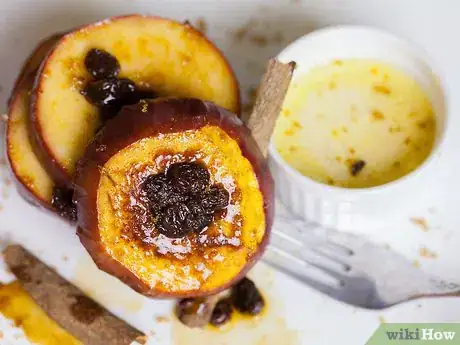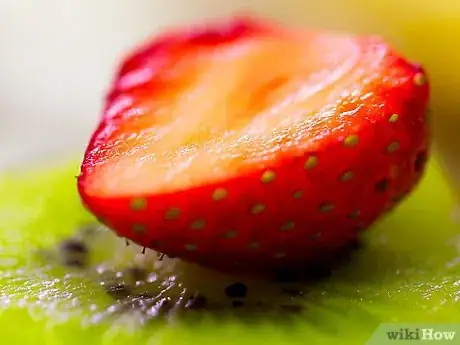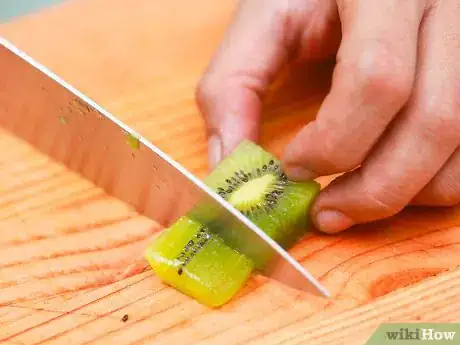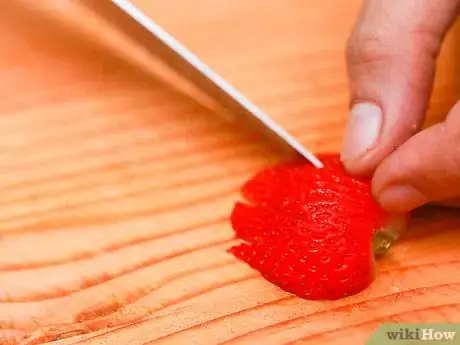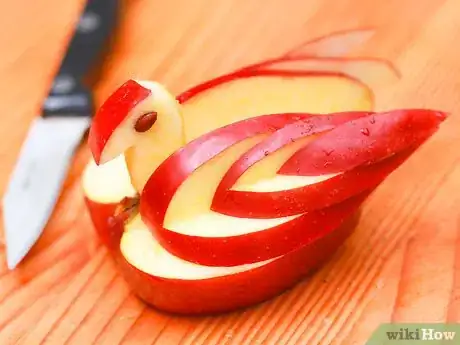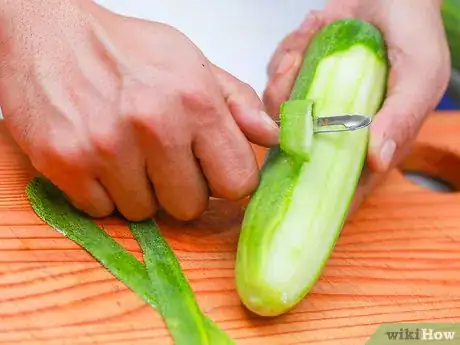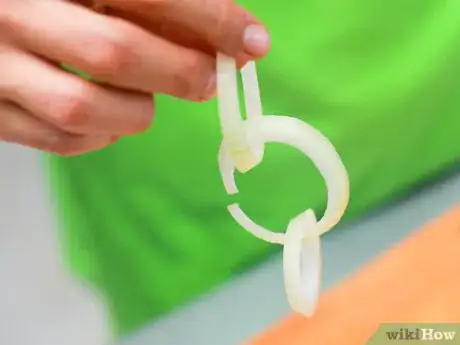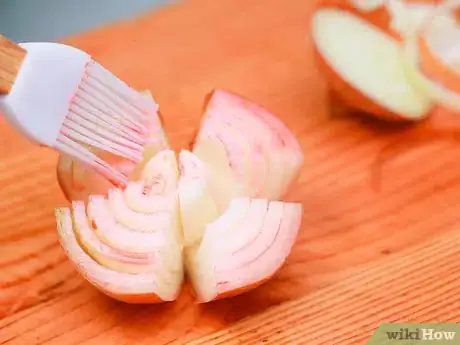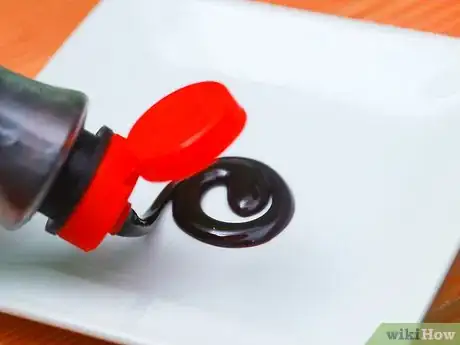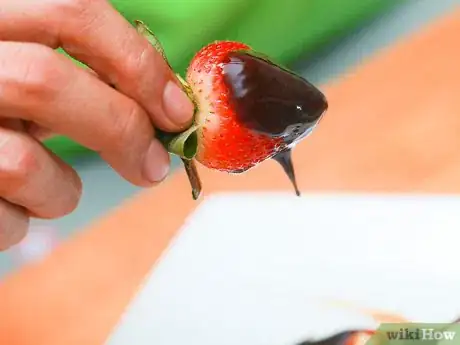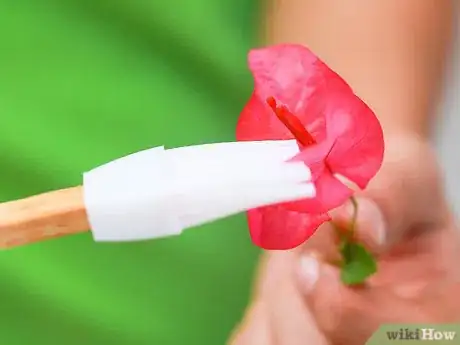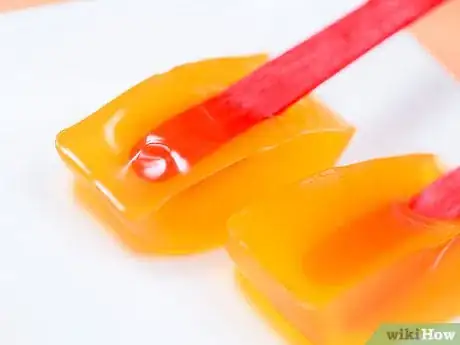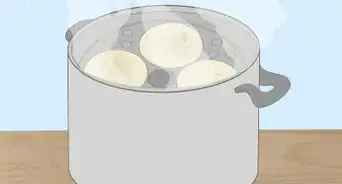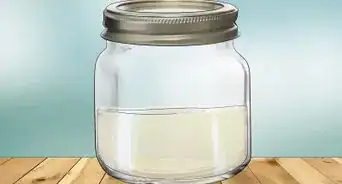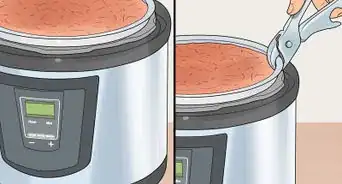This article was co-authored by JoAnna Minneci. JoAnna Minneci is a Professional Chef based in the Nashville, Tennessee area. With more than 18 years of experience, Chef JoAnna specializes in teaching others how to cook through private cooking lessons, team-building events, and wellness and nutrition classes. She has also appeared in numerous television shows on networks such as Bravo and Food Network. Chef JoAnna received Culinary Arts training from the Art Institute of California at Los Angeles. She is also certified in sanitation, nutrition, kitchen management, and cost control.
There are 9 references cited in this article, which can be found at the bottom of the page.
This article has been viewed 184,792 times.
Knowing how to garnish food can be confusing for anyone who hasn't tried it in the past. A garnish is often best as a simple, colorful ingredient, so don't feel you need to craft a whole new recipe to pair with your meal. If you are looking for more involved ideas, there are plenty of creative options to try for any type of entrée or dessert.
Steps
Selecting a Garnish
-
1Make all inedible garnishes easily identifiable and removable.[1] Cocktail umbrellas and birthday candles are common examples of inedible garnishes that are difficult to replace with edible material. However, these items are obviously inedible and easily removed from the food, so there is little chance of anyone eating them. Make sure any other inedible ingredients you use share these characteristics.
-
2Decide whether to use strong flavors or bland ones. Bland dishes may call for garnishes sprinkled with herbs or spices, but every garnish doesn't need to have a strong taste. If the food already has a complex flavor, it's usually a good idea to avoid flavorful garnishes which could clash with other ingredients.[2]Advertisement
-
3Vary the color and texture. Pick a color that contrasts with the color of the dish, so the garnish is more visible and appealing. Similarly, a small piece of a crunchy vegetable adds variety and interest to a soft dish.
- Two-ingredient garnishes can be laid out in alternating layers on a plate, creating a contrast between two colors. Try slices of tomatoes and cucumbers, or two different colors of gelatin cubes.
-
4Arrange the garnish on the dish. Garnish may catch the diners' eye more readily on a contrasting background. If the food itself contains several colors, place the garnish directly on the plate or bowl. Most garnishes show up well on white tableware, but bright-colored garnishes may work well on a dark ceramic dish as well.
- Remember that the garnish is usually there to accentuate the main dish, not become an art project unto itself. Two or three pieces of garnish arranged at intervals may be more attractive than a continuous border or a large pile.[3]
-
5Keep the temperature in mind. Frozen garnishes may melt if placed next to hot food. Even if not in danger of losing its shape, a large, cold garnish may be unpleasant to eat with a hot soup, and a hot garnish likely won't pair well with a cold dessert.[4]
-
6Use edible garnishes whenever possible. Garnishes are not only for decoration; they can add new flavors and textures to the meal as well.[5] Using edible garnish also avoids the hassle of having to remove the garnish before eating.
Garnishing with Fruit
-
1Learn when to use fruit garnishes. Most fruits are sweet, and best used to decorate desserts, or salads when used in small quantities. Citrus fruits, such as lemons and limes, are excellent for adding color and flavor to dishes containing fish and lightly flavored meat, as well as other fruits and desserts.
- Citrus fruits can be made into attractive garnish simply by cutting them into thin circles, wedges, or twists. See below for advice on preparing other fruit.
-
2Cut simple fruit squares. Choose a firm fruit with segments or a varied internal appearance, such as an orange or kiwi. Cut out a rectangular block from the center of the fruit, then slice this into flat squares.
- Use several fruits of different colors for variety. Some of these can be fruits with a plainer appearance, such as cantaloupe or mango, cut into squares or scooped out into spheres with a melon baller.
-
3Create a strawberry fan. Wash and dry a strawberry. Using a paring knife, make four or five slices from the tip of the strawberry toward the top, but leave a small piece around the stem intact. Gently fan out the slices of the strawberry on the plate you wish to decorate.
-
4Cut a Maraschino cherry into a flower shape. Cut a cherry two-thirds of the way through the fruit. Turn the cherry and make two more cuts, dividing the cherry into six "petals" without cutting them apart from each other. Spread the petals carefully apart and press them flat.[6]
- Optionally, add a small piece of candied fruit or other edible material to the center, and place one or two mint leaves underneath it.
-
5Create sugared fruit garnishments. Wash any firm fruit, then blot dry with a paper towel. Separate an egg white into a bowl and beat it until it becomes foamy. Brush the egg white onto the fruit in a thin, even coat, then sprinkle with white granulated sugar for a frosted appearance.[7]
-
6Make an apple swan. If you have a little more time and a sharp knife, try making a swan design out of an apple, as described in the linked article. Large radishes or other hard, large fruit or vegetables can be used instead.
- Other complex designs can serve as centerpieces or garnishes for special occasions. You can find many of these online by searching for Thai fruit carving instructions, or for "food art."
Garnishing with Vegetable, Flowers, and Herbs
-
1Use these ingredients for savory dishes. Vegetables and flowers make excellent garnishes for salad, meat, vegetable dishes, pasta, and rice. If you're not sure which vegetable or flower to use, pick one that was used as an ingredient in the food, or go with a mild-tasting vegetable such as cucumber or daikon radish.
-
2Create a flower from a carrot or cucumber. Wash half of a cucumber or carrot, and peel off any dirty or bumpy skin. Use a paring knife to cut a strip down the length of the vegetable, but don't cut it off entirely. Repeat to form a series of "petals" around the carrot or cucumber. If there's room, make a second, inner layer of petals the same way. Remove the thick inner portion, and gently bend the petals outward.[8]
-
3Craft a tomato rose. Peel a tomato skin in one long, spiral strip from one end to another, making the strip narrower and narrower as you go. Curl this strip of skin into a tight curl, then release it to form a flower shape. You may need to tuck the narrow end in between two folds of the spiral to keep it in place, or use a toothpick to fasten it more firmly.
-
4Link a chain of vegetable rings. White onions, all bell peppers, and even hollowed-out cucumbers can easily be cut into rings. Make these fancier by cutting a slit into each ring, and forming an interlocking chain to place on top of the food or around the serving dish.[9]
-
5Use food coloring to create an onion garnish. Slice a white onion into segments, but leave the root at the base to keep them together. Dip the onion in hot water to make it firm and reduce the onion scent, then soak it in food coloring for twenty or thirty minutes so it develops an attractive, muted color.[10]
-
6Choose edible flowers. Violets, roses, geraniums, marigolds, and nasturtiums are all examples of edible flowers, but look up other flowers before you add them to food, since some flowers are toxic. Never eat flowers grown near roads or other sources of pollution, flowers that have had pesticides used on them, or flowers of unidentified species. Only some flowers are edible, and even those should be used sparingly to avoid causing digestive issues.[11] All that said, a flower blossom is simultaneously one of the easiest and most attractive garnishes available.
- The taste of a flower can change with variety, time of year, and the environment it was planted in. Taste a petal before you use it as garnish, even if you've eaten that species of flower before.
-
7Use a sprig of herbs. One of the simplest and most common garnishes is a sprig of parsley. This is a great addition to dishes with rich, meaty or heavy flavors, as it balances it out with a lighter, more natural ingredient. You can also use rosemary leaves, mint, or other herbs, but remember to remove inedible stems first.
- Sometimes, a sprinkle of ground herbs or spices is all a dish needs. Paprika, chili powder, and turmeric are all brightly colored enough to serve as garnishes by themselves.
Garnishing with Dessert Ingredients
-
1Use drizzled chocolate to make shapes. You can drizzle zig zags straight onto desserts or plates, using melted chocolate or chocolate syrup. For more complicated designs, try piping melted chocolate onto a baking sheet lined with waxed paper. Transfer the sheet carefully to the refrigerator or freezer for about ten minutes, or until the chocolate is cold and solidified.[12] Prop these designs vertically in ice cream or lay them flat onto any cold dessert, immediately before serving.
- Use dark, white, and milk chocolate to create a varied appearance.
-
2Dip fruit in chocolate. Strawberries, grapes, or cubes of any fruit can be dipped in chocolate and chilled to harden into a delicious dessert in their own right. Stick them onto skewers and arrange them in a fan shape by sticking the other end of the skewer into a halved melon containing fruit salad or another dessert.
-
3Sugar coat edible flowers. Use an edible flower grown without pesticides, preferably one with a pleasant scent. Whip an egg white until it foams, then use a brush to coat the flower. Sprinkle white granulated sugar over the flower, and use sparingly as a topping for rice pudding or other desserts.
-
4Use colored gelatin in molds. Any flavored liquid can be mixed with gelatin powder, from herbal tea to fruit juice. Heat according to the instructions on the gelatin packaging, then pour into molds and chill until the gelatin sets. If you don't have any decorative molds, cut the gelatin manually into cubes, diamonds, or other shapes.
- You can even use soup stock or savory herbs in water to create savory gelatin.
Expert Q&A
-
QuestionWhat can be used to garnish food?
 JoAnna MinneciJoAnna Minneci is a Professional Chef based in the Nashville, Tennessee area. With more than 18 years of experience, Chef JoAnna specializes in teaching others how to cook through private cooking lessons, team-building events, and wellness and nutrition classes. She has also appeared in numerous television shows on networks such as Bravo and Food Network. Chef JoAnna received Culinary Arts training from the Art Institute of California at Los Angeles. She is also certified in sanitation, nutrition, kitchen management, and cost control.
JoAnna MinneciJoAnna Minneci is a Professional Chef based in the Nashville, Tennessee area. With more than 18 years of experience, Chef JoAnna specializes in teaching others how to cook through private cooking lessons, team-building events, and wellness and nutrition classes. She has also appeared in numerous television shows on networks such as Bravo and Food Network. Chef JoAnna received Culinary Arts training from the Art Institute of California at Los Angeles. She is also certified in sanitation, nutrition, kitchen management, and cost control.
Professional Chef Fresh herbs are almost always nice, but put them on the food, not just scatter them on the plate. Make sure that anything that you use as garnish is something that you can eat.
Fresh herbs are almost always nice, but put them on the food, not just scatter them on the plate. Make sure that anything that you use as garnish is something that you can eat. -
QuestionWhat are the rules of garnishing?
 JoAnna MinneciJoAnna Minneci is a Professional Chef based in the Nashville, Tennessee area. With more than 18 years of experience, Chef JoAnna specializes in teaching others how to cook through private cooking lessons, team-building events, and wellness and nutrition classes. She has also appeared in numerous television shows on networks such as Bravo and Food Network. Chef JoAnna received Culinary Arts training from the Art Institute of California at Los Angeles. She is also certified in sanitation, nutrition, kitchen management, and cost control.
JoAnna MinneciJoAnna Minneci is a Professional Chef based in the Nashville, Tennessee area. With more than 18 years of experience, Chef JoAnna specializes in teaching others how to cook through private cooking lessons, team-building events, and wellness and nutrition classes. She has also appeared in numerous television shows on networks such as Bravo and Food Network. Chef JoAnna received Culinary Arts training from the Art Institute of California at Los Angeles. She is also certified in sanitation, nutrition, kitchen management, and cost control.
Professional Chef Every garnish should be edible and contrasting colors, ideally an element that is part of the dish. It's going to change the whole flavor profile of the dish.
Every garnish should be edible and contrasting colors, ideally an element that is part of the dish. It's going to change the whole flavor profile of the dish. -
QuestionWhat is the name of a garnish used often on sandwiches that is very small like little peas and is very salty?
 WikiHow Editor 284648Community AnswerProbably capers, a sort of flower button stored in a salty/acid liquid. You can find it in jars.
WikiHow Editor 284648Community AnswerProbably capers, a sort of flower button stored in a salty/acid liquid. You can find it in jars.
References
- ↑ JoAnna Minneci. Professional Chef. Expert Interview. 23 November 2021.
- ↑ http://www.education.com/reference/article/making-meal-food-garnish-ideas/
- ↑ http://www.oldandsold.com/articles02/food1.shtml
- ↑ http://www.oldandsold.com/articles02/food1.shtml
- ↑ JoAnna Minneci. Professional Chef. Expert Interview. 23 November 2021.
- ↑ http://recipes.howstuffworks.com/tools-and-techniques/how-to-garnish-cooking3.htm
- ↑ http://recipes.howstuffworks.com/tools-and-techniques/how-to-garnish-cooking3.htm
- ↑ http://www.oldandsold.com/articles02/food8.shtml
- ↑ http://www.oldandsold.com/articles02/food13.shtml
About This Article
If you want to garnish food, use edible garnishes, like fruits, veggies, or seeds whenever you can. To garnish an appetizer or entrée, sprinkle on some sesame seeds for texture or add a lemon wheel to fish and chicken dishes. When garnishing a dessert, try adding little squares of kiwi or orange. If you want something fancier, make a strawberry fan by cutting a clean dry strawberry in half lengthwise. Then, make 4-5 slices from the tip most of the way to the stem and fan them out on the plate for a lovely effect. To learn how to make a vegetable rose, scroll down.





